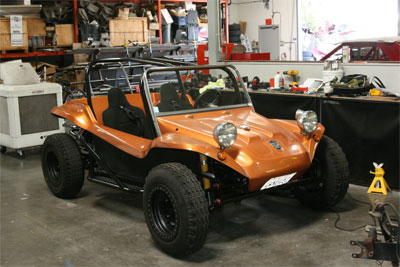 |
|
This 60s-era Volkswagen dune buggy is newly customized, Streetwise kept nothing except for the original body and windshield frame.
|
In 2004, Doug Nagy and his wife decided to break away from their 20-year involvement with running road race teams to set up shop as a full-time 7,000 sq. foot performance fabrication facility. The Nagys’ part-time passion for the hobby of fabrication had turned into a full-time business called Streetwise, based in Rancho Santa Margarita, Calif.
Streetwise focuses on a niche market of rally and drift racing and high-end hot rods, specializing in the type of fabrication that the bolt-on shops can’t cater to. Their mostly Southern California customers turn to them for their experience in everything from roll cage installations to upgrading a suspension system a certain way for safety and regulatory compliance.
A large stack of racing rulebooks that occupy a corner of Nagy’s office dictates the fabrication regulations for each type of race configuration. Because stock parts and kits are manufactured with a wide range of tolerances to accommodate installation in a wide range of vehicles, most of Streetwise’s work specifies fabricating from scratch or modifying a stock part for a certain car.
“Everything we do is bent and built from scratch,” states Doug Nagy, owner, Streetwise. That even includes tools needed in racing, such as the innovative tire shaving machine Streetwise is building for a customer. (See sidebar).
 |
|
Streetwise will be using a Miller Spectrum 625 plasma cutter, Syncrowave 250 DX TIG welder and an older Millermatic 135 MIG welder to turn this salvaged 1990 Mustang GT into a street-legal rally and showcase car.
|
To provide this custom touch for rally and drift cars, Streetwise relies on a variety of Miller MIG, TIG and plasma cutting equipment to tackle the body paneling, maintenance, repairs, installations and restoration.
Nagy chose Miller over competitive brands for a simple reason. “The equipment doesn’t break,” says Nagy. “I remember having a lot of downtime with other types of welders due to such things as electronic board failures, while the Miller unit that we carry in the truck and have ‘beat on’ for years at all the races still runs great.” Nagy also credits the positive experience he’s had with Miller technical support for his loyalty to the company.
Almost every job the rolls into the shop is touched by a Miller. Nagy outfitted his shop with a Spectrum® 625 plasma cutter, a Syncrowave® 250 DX TIG welder, an Econotig® TIG welder and an older Millermatic® 135 primarily used for quick tack welds.
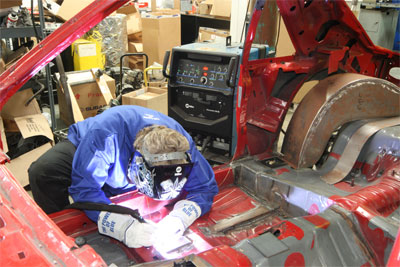 |
|
Doug Nagy, owner, Streetwise, uses the Syncrowave 250 DX to TIG weld the passenger-side floor pan directly to chassis cross-members. The deep penetration helped Doug with the thicker steel that was used for as the mounting plates for the roll bar, which will be installed later.
|
Taking the Shop Car to New Heights
At press time, Streetwise was in the process of refitting a 1990 Mustang GT that would serve as street-legal rally and showcase car embodying all of Streetwise’s skills and capabilities. Streetwise purchased the car under a salvage title – as the vehicle had suffered a fairly severe front-end collision. The resurrection and metamorphosis of the battered GT is significant, encompassing major changes to the engine, body, chassis and wheels. These include a Double A Arm front suspension – to enable use of much larger wheels with a desired proper offset – in addition to an independent rear suspension (IRS). The engine is a Shelby GT500 5-4 motor with a centrifugal blower, which will boost the power to 700 HP, and the car will be outfitted with large 4-piston, 15-inch front brakes and 13-inch rear brakes to properly harness the Mustang’s power in turning.
Streetwise will upgrade this vintage car with several modern-day amenities including: air-conditioning, emissions controls, a stereo and a stylish interior. Instead of a roll cage, Streetwise chose to install a NHRA-spec roll bar to enable faster entries and exits from the street-legal car. Nagy says the modified Mustang GT is scheduled for completion by April 2009; in time for the Fabulous Fords Forever show in Knott’s Berry Farm, Rancho Santa Margarita. If they finish ahead of schedule, they can “start playing around with it sooner.”
“Even though we call it a show car, we’ll end up beating on it – we tend to drive everything we have around here,” Nagy remarks. “It should run high 10’s on the drag strip and also be pretty fast on a road race track for a Time Attack style event.”
The Syncrowave 250 DX TIG welder and Millermatic 135 have already been put to use in many Mustang project applications. The Shelby GT500 motor is significantly different dimensionally than the standard GT engine, so Nagy’s crew worked to fabricate new motor mount brackets and modify the cross member, and created all new radiator mounts for an upgraded radiator – both of which required TIG welding within the engine compartment.
Streetwise’s Syncrowave 250 DX features a 5- to 310-amp output range with a 40 percent duty cycle rating at 250 amps. Like all Syncrowave machines, its squarewave balance control permits tailoring the arc for more cleaning action to remove heavy oxide layers or more penetration on thicker material. Nagy can also choose from three arc characteristics built into the Syncrowave to optimize its behavior for a specific application: Soft Start, Standard Start and Hot Start. Standard Start is Miller’s default setting and good for everyday welding. Soft Start helps when working with small diameter tungsten or thin metals, while Hot Start improves starts with the larger diameter tungsten used for welding thicker materials, such as welding the new engine mounts to the Mustang’s chassis.
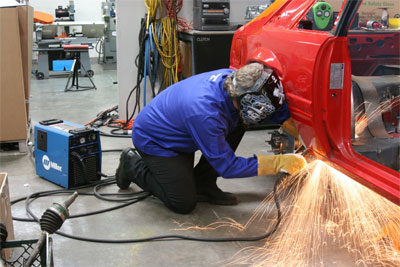 |
|
With a rated output of 40 amps/140 VDC at 50 percent duty cycle, the Spectrum 625 can sever up to 7/8-in. thick and also cut 5/8-in. steel at a rate of up to 10IPM. The speed is a big benefit to Nagy, allowing him to work faster and bring more work into the shop.
|
Streetwise also installed a 6-speed transmission, after MIG fabricating a brand new tunnel of 18-gauge sheet metal (including a new heavy-duty shift boot mount) to replace the stock tunnel, which wouldn’t accommodate the new transmission. Additional TIG welding was needed to reconfigure the bolt-in IRS to enable fitting of a much wider rear tire. TIG also provides a “proper finished look” to the tubes comprising the suspension, Nagy notes.
“We’re also installing a 1.75-in. 120 wall DOM roll bar and 16-gauge mini-tubs for the rear wheels, so there is quite a bit of interior sheet metal work that had to be done with MIG,” Nagy adds. “Additionally, we fabricated structural braces for the sub-frame made of 2-in. 12-gauge box that we actually had to sink into the floor to connect the front and rear, to allow us to run the car at a lower ride height.”
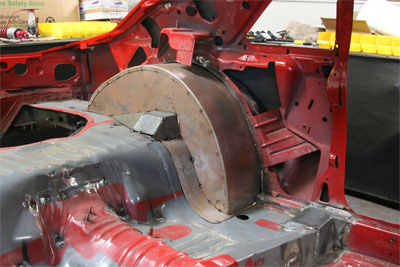 |
|
Because the car will sit lower, Nagy fabricated these deeper wheel tubs, tacking the sheet metal into place. Note the small box, this is for the new independent rear suspension system.
|
Flawless Buggy Customization
The ability of TIG welding to create attractive finished beads also made sense in another recent Streetwise project, rehabbing a 60s-era Volkswagen dune buggy. Nagy’s team put a completely fabricated chassis under the body with a full roll cage and side protection, in addition to upgrading the suspension, brakes, engine and transmission.
“Basically the only thing we kept from the original buggy was the body and windshield frame,” Nagy recalls. “Everything else – all the running gear – has been completely updated to modern technology and fabricated heavy-duty suspension. So, it’s much safer now, it handles much better and drives much better overall.”
The Syncrowave 250 DX TIG helped provide a nice, finished look to the “exposed” buggy architecture – particularly since the roll cage required custom fabrication from the standard roll cage template. “We moved the bars in for the head clearance, and some other things, just to make it a little more user friendly for everyday use,” he says. “I think most of its life is going to be spent going back and forth to the beach with surfboards on the top.”
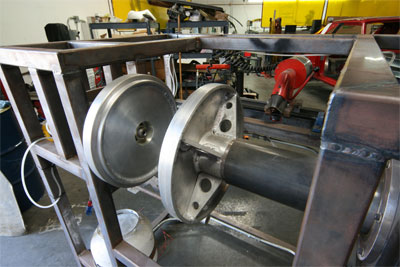 |
|
Prepping tires for drag and rally racing has long been a laborious task that required someone with exceptional skill. Streetwise designed and welded this machine, which automates the process, increasing consistency and speed. Note the red shaving mechanism in the back. It makes quick work of the job as the inflated tire spins.
|
Speed: Plasma Cutting’s Advantage
Another useful time-saving tool at Streetwise has been the Spectrum 625 plasma cutter, which has significantly simplified and accelerated structural and body work over the last four years, he says.
“I didn’t realize how much I’d use the Spectrum 625 until I got it and found out how much stuff I could do with it,” Nagy observes. “There are so many things that are much easier, faster and more accurate to cut with the plasma cutter than with the band saw. That includes modifying sub-frame pieces, notching body panels to fit reinforcement or tweaking a roll cage fitment. It’s a lot simpler to use the Spectrum 625 than to try to grind it or saw it out. Plus, it’s a lot easier to get access with the plasma cutter when you’re working right on the car’s frame.”
With a rated output of 40 amps/140 VDC at 50 percent duty cycle, the Spectrum 625 can sever steel up to 7/8-in. thick and also cut 5/8-in. steel at a rate of up to 10 IPM. It increases productivity on thinner metals, slicing through 1/4-in. steel at a rate of more than 60 IPM and 1/8-in. steel at 200 IPM.
The half-inch market is one of the biggest markets in plasma cutting because so many people routinely cut mild steel, stainless steel and aluminum in the 1/4- to 1/2-in. range.
Speed is the key, Nagy adds. “Time is money. The faster I can work through projects, the more efficient I can be, the more money I can make.”